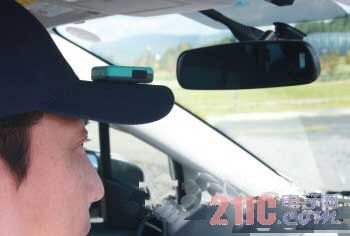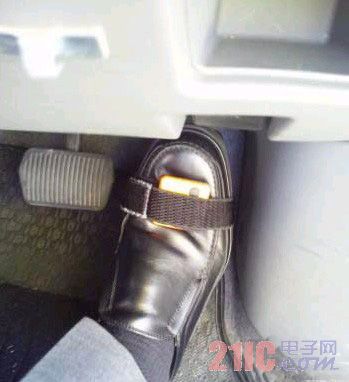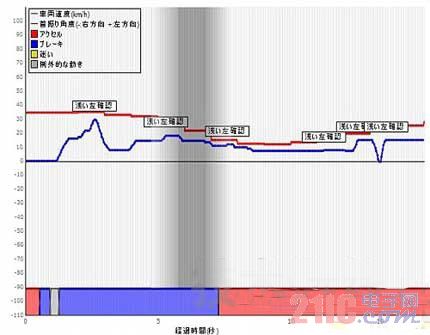ATR prevents new accidents in traffic accidents and uses sensors to improve driving skills
How can we reduce the number of deaths from traffic accidents?
This article refers to the address: http://
The representative answer is probably the airbag system that protects the occupant during a collision, and the vehicle structure that mitigates the impact of the collision. The number of traffic accident deaths in Japan has been decreasing year by year, and it has been reduced to less than 5,000 in 2009. It is recognized as a contribution to the progress of the car safety system. In January 2006, the IT strategy headquarters of the Japanese Prime Minister Junichiro Koizumi, who was then the minister, issued a statement stating that the goal of “the safest transportation society in the world†would be to reduce the number of traffic accident deaths to 5,000 in 2012. "The following", in fact, the goal has been achieved significantly ahead of schedule. In the future, the number of traffic accident deaths is expected to decrease further with the spread of collision prevention safety systems that can reduce the impact of accidents and the expansion of intelligent transportation systems (ITS) that can prevent collisions and rear-end collisions.
But is it only a car safety system to reduce the number of deaths from traffic accidents? In fact, the number of traffic accidents has exceeded 700,000. Although it has been reduced for a while, it is still at a high level. The fatality rate (the number of deaths divided by the number of casualties) was 0.54%, which has not continued to decline in recent years. If you do not reduce the number of traffic accidents, it will be quite difficult to significantly reduce the number of deaths from traffic accidents. Although the popularity and expansion of ITS is expected to prevent traffic accidents, if the driver's driving skills are further improved, traffic accidents should be less.
Under this circumstance, the International Institute of Electrical and Telecommunications Basic Technology (ATR) carried out an activity to quantitatively evaluate the driver's technology using electronic technology and improve the driver's safety awareness by feedback evaluation results. The driver's normal driving behavior, such as determining the right and left certainty (the angle and time of the neck), the speed at the time of turning, the timing of stepping on the accelerator pedal, and the brake pedal, are all digitized. And find the driver's driving habits, and determine the deviation from the ideal driving. By causing the driver to recognize the results of the objective evaluation, the potential dangers in driving "habits" are exposed, thereby eliminating traffic accidents in a "sprout" state. A few days ago, the reporter has been expanding the scope of application since the practical use in 2008, and has been interviewing the ATR system that collects the verification data, and explored its effect on prevention of safety.
Use the sensors on the head and right foot to grasp the driver's situation
The ATR system uses a 3-axis accelerometer, a 3-axis gyroscope sensor, and a sensor module with a 3-axis geomagnetic sensor for different performance specifications. The driver wears a hat with the sensor module installed and the same module is installed on the right foot (Fig. 1). The sensor module of the hat is responsible for detecting data such as the angle of the face toward the left and right, and the sensor module of the right foot detects data such as the accelerator pedal or the brake pedal. The module's external dimensions are only 39mm × 44mm × 12mm, and the weight is only 20g, so it will not hinder driving. In addition to this module, the system uses GPS modules that determine the location of the vehicle, as well as small devices that store the data for these modules. The data detected by the sensor module is transmitted to the small device via Bluetooth.

(a) Hat with sensor module installed

(b) the state in which the sensor module is mounted on the right foot
Put into practical use in August 2008, starting with training professional drivers
The inspection system is based on the basic research of ATR, which was developed by ATR and Shancheng Automobile Driving School in 2008 (the business is carried out by ATR-Sensetech). The system was used as an "Objet System" to automatically evaluate the driver's driving skills and provide suggestions for improvement. In August of the same year, the system was used in the professional driver training of the Yamagata Motor Driving School.
The test data is expressed as a change in time by changing the position of the right foot (located on the accelerator pedal, brake pedal, or unstable), neck twist angle, and vehicle speed (Fig. 2). It is said that only by using three projects in the district, it is possible to know whether the neck torsion angle during turning is sufficient to confirm the left and right, whether the confirmation time is sufficient, whether the vehicle is slowing down, and whether the timing of stepping on the accelerator pedal is appropriate. In combination with the evaluation of individual cases, such as when going straight and when turning left and right, the overall driving situation is evaluated by a score (out of 100 points) or five levels.

Figure 2: Example of driving skill evaluation (when passing the intersection)
The blue waveform is the action of turning the neck to the left and right, and the red waveform is the driving speed. The red band in the lower part of the figure is the pedal pedal on the right foot, and the blue part represents the stepping on the brake pedal.
If the neck is less than 10 degrees, it is not enough to confirm the left and right, even if the neck is large, if the time to confirm the left and right is short, it is not sufficient (Figure 3). If the driver hesitates "is walking or stopping", there will be data on unstable foot position. Just look at the waveform, it is not just the driver's driving habits, even when turning, "I can't see the person, don't pay too much attention?" and so on, "the driver's thoughts can also be seen" (ATR Intelligent Robot Research Institute Environmental Intelligence Laboratory) Wild spring). Data including personal differences such as the speed at the time of turning, the degree of deceleration when going straight at a poor view, etc. can be known truthfully (Shancheng Motor Driving School calls this speed that varies from person to person as the individual's "holding speed").

Figure 3: Example of driving skill evaluation (when the intersection turns left)
It can be seen from the small change of the blue waveform that the driver's necking movement is small, and the left and right confirmation is insufficient.
In addition to the test data, the features seen from the test data will also be presented to the driver in a concise text (Figure 4). By numerically digitizing the driver's driving habits and mental state, it is easy to understand the short comment to the driver, so that the driver can easily notice his own danger. The test data is evaluated by preparing a plurality of driver's safe driving behavior patterns as a reference, and extracting the driver's characteristics by comparing them with the detected data. The short review can give a detailed evaluation according to the degree of danger of “slight attentionâ€, “attention†and “need to improveâ€. Shancheng Motor Driving School said that by using the Objet system for driving evaluation every three to six months, the driver has developed a safe driving method.
Draw the driver to notice the blind confidence in their "technical"
Since its introduction in 2008, the scope of application of the Objet system has expanded. The Objet system has evaluated more than 3,000 drivers.
The driving school adopted has increased to 16 in 11 prefectures. A taxi company uses its training taxi drivers, and the truck associations in Kyoto and Nara Prefecture use it to provide training services to member companies. The Beijing City Transportation Bureau and the Nagoya City Transportation Bureau also used the system in the training of bus drivers, and JR West Japan Bus applied it to train long-distance bus drivers. In addition to training professional drivers, Kyoto Prefecture and Gifu Prefecture have identified training using the Objet system as a certification course for the elderly.
It is said that the effect is very obvious. For example, after a taxi company trained the driver who had an accident using the Objet system, the number of drivers who received the second training (ie, the driver who was trained again after the accident) was reduced by about 20%. It can be seen that for a professional driver with a good self-confidence driving skill, it is very effective to take out the objective data of the value when pointing out its shortcomings.
As far as the shortcomings of confident drivers are concerned, it is equally effective in training for the elderly. ATR said that in the evaluation of his driving skills divided into 5 (5 is the best), middle-aged people are slightly lower than 4, while older people are slightly higher than 4. The Objet system's actual evaluation of 314 elderly people showed that in the 5th grade evaluation, the proportion of the worst skills accounted for about 20% of the total, which is more than three times that of the average driver. ATR said that although the elderly are driving at a safe speed and observing temporary parking, the timing of confirming safety when turning right and left is also very accurate, but the angle of the neck and the confirmation time when turning left and right are insufficient. This situation is clearly reflected in the test data. By showing them practical skills, many older people have discovered the gap between their actual car skills and subjective perceptions.
Can also be used to design safe roads
In addition to cars, the system can also be used to implement bicycle safety driving training, and to optimize the way ITS provides information based on numerical driver behavior, and even to design roads that are less prone to traffic accidents.
The application in the ITS has been verified by the Hanshin Expressway in the road-car coordinated ITS information providing service verification experiment "King Hanshin Area Intelligent Road Verification Experiment". In the road-car coordinated service, the system can send information such as “front traffic jam, pay attention to rear-end†and “confluent vehicles on the right side, please pay attention†according to the road conditions, and display information on the car navigation device to remind the driver to pay attention. To prevent accidents from happening. In the verification experiment, ATR and Osaka University investigated in detail the actions taken by the driver after receiving the information.
The subjects were 32 publicly recruited drivers aged 20-50. They wore a hat with a sensor module on their head and the same module on the right foot, investigating the behavior after seeing the traffic information. In the location where the sidewalk vehicles flowed from the right side to the main line, the experimental results showed that the driver saw the message “Converging vehicles on the right side, please pay attentionâ€, and before slowing down the throttle for 0.23 seconds (average value), With the action of looking at the right direction. When the traffic jam is in the current direction, the driver relaxes the accelerator pedal after 1.77 seconds after seeing the traffic jam information. Based on these results, the ATR will investigate the impact of the timing, display position, and display content of the information on the driver's line of sight movement and pedal operation in the future, thereby making the ITS information providing service more effective.
Regarding road design, ATR and the construction and construction consultants engaged in road design jointly verified. Using the Objet system, it was investigated whether the movements of the driver's hands, feet, and neck were adapted to road conditions such as road structures and traffic rules.
Verification was carried out at the junction of the side road and the main line on the ordinary road in Matsuzaka City, Mie Prefecture. The behavior of the driver wearing the Objet system from the sideways to the main line was investigated. The results showed that many drivers did not stop completely at the "temporary parking" location. Although there was action to confirm the right side (trunk direction), the throttle The pedal is not released and the right foot moves from the brake pedal to the accelerator pedal for a while. According to this result, it is possible to take measures such as widening the parking position, setting the road pile, adjusting the signs on the side roads, and the like to solve the problem of incomplete parking and insufficient confirmation of left and right.
From "individual" to "social"
In order to further expand the application range of the Objet system, ATR is scheduled to hold a seminar on October 28, 2011. It is hoped that a platform for users and researchers who use the Objet system to create communication will be widely consulted to promote the development of the Objet system. ATR is studying strategies to promote the system to the average driver in the future. For example, as the popularity of the Objet system increases, if insurance companies are interested in it, voluntary insurance linked to driving technology will be introduced. In that case, the opportunity for ordinary drivers to use the Objet system is expected to increase.
Moreover, the evaluation system also needs to be developed. Although the existing system is small in size, it is necessary to set the sensor module every time driving. This inconvenience may discourage users. This problem can be solved by using optical techniques and camera technology to detect the behavior of the neck and right foot. If a vehicle with an evaluation system is installed on the road, it is estimated that the driver's behavior and road conditions can be read. It will also consider the use of maps to identify drivers who are having difficulty driving and are prone to panic. “The Objet system has done a good job of making a good evaluation for everyone. The next stage is to collect the behavior of a large number of drivers and apply them to social servicesâ€
Indoor Fixed LED Display is a popular product for its high quality, every year sold to at least 80,000 pieces around the world, including Europe, North America, southeast Asia.Compared to other indoor LED display in the market, its biggest advantage is that it can display high-definition images while maintaining low power consumption.Besides, it adopts Die casting aluminum cabinet which is ultra-thin and ultra-light and owns good heat dissipation.Easy to install and maintain and suitable for multiple indoor scenes.
Application:
* Business Organizations:
Supermarket, large-scale shopping malls, star-rated hotels, travel agencies
* Financial Organizations:
Banks, insurance companies, post offices, hospital, schools
* Public Places:
Subway, airports, stations, parks, exhibition halls, stadiums, museums, commercial buildings, meeting rooms
* Entertainments:
Movie theaters, clubs, stages.
Indoor Fixed LED Display,Led Wall Display,Video Wall Display,Outdoor Led Screen Display
Guangzhou Chengwen Photoelectric Technology co.,ltd , https://www.cwstagelight.com